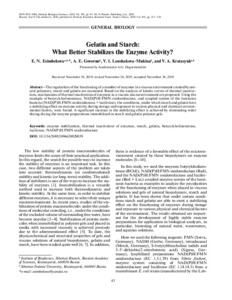Показать сокращенную информацию
Gelatin and starch: What better stabilizes the enzyme activity?
| Автор | Esimbekova, E. N. | |
| Автор | Govorun, A. E. | |
| Автор | Lonshakova-Mukina, V. I. | |
| Автор | Kratasyuk, V. A. | |
| Дата внесения | 2021-08-13T09:31:47Z | |
| Дата, когда ресурс стал доступен | 2021-08-13T09:31:47Z | |
| Дата публикации | 2020-03 | |
| Библиографическое описание | Esimbekova, E. N. Gelatin and starch: What better stabilizes the enzyme activity? [Текст] / E. N. Esimbekova, A. E. Govorun, V. I. Lonshakova-Mukina, V. A. Kratasyuk // Doklady Biological Sciences. — 2020. — Т. 491 (№ 2). — С. 43-46 | |
| ISSN | 00124966 | |
| URI (для ссылок/цитирований) | https://link.springer.com/article/10.1134/S0012496620020039?wt_mc=Internal.Event.1.SEM.ArticleAuthorOnlineFirst | |
| URI (для ссылок/цитирований) | https://elib.sfu-kras.ru/handle/2311/142634 | |
| Аннотация | The regularities of the functioning of a number of enzymes in a viscous environment created by natural polymers, starch and gelatin are examined. Based on the analysis of kinetic curves of thermal inactivation, mechanisms of thermal inactivation of enzymes in a viscous microenvironment are proposed. Using the example of butyrylcholinesterase, NAD(P)H:FMN oxidoreductase, and coupled system of the luminous bacteria (NAD(P)H:FMN oxidoreductase + luciferase), the conditions, under which starch and gelatin have a stabilizing effect on enzyme activity during storage and exposure to various physical and chemical environmental factors, were found. A significant increase in the stabilizing effect is achieved by eliminating water during drying the enzyme preparations immobilized in starch and gelatin polymer gels. | |
| Тема | иммобилизация ферментов | |
| Тема | крахмал | |
| Тема | желатин | |
| Тема | термостабильность ферментов | |
| Название | Gelatin and starch: What better stabilizes the enzyme activity? | |
| Тип | Journal Article | |
| Тип | Journal Article Postprint | |
| Страницы | 43-46 | |
| Дата обновления | 2021-08-13T09:31:47Z | |
| DOI | 10.1134/S0012496620020039 | |
| Институт | Институт фундаментальной биологии и биотехнологии | |
| Подразделение | Кафедра биофизики | |
| Журнал | Doklady Biological Sciences | |
| Квартиль журнала в Scopus | Q2 |

